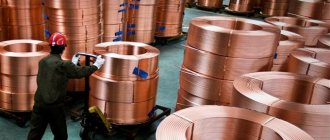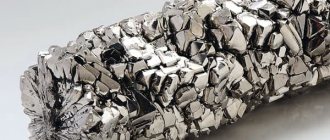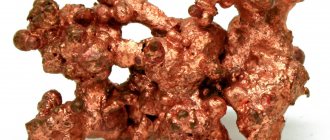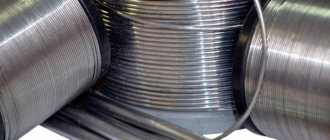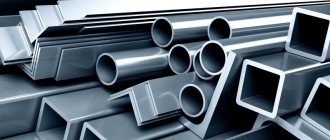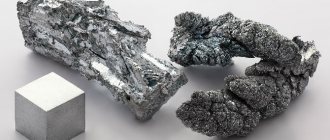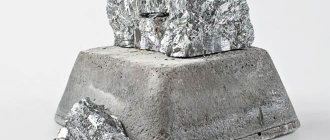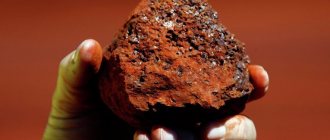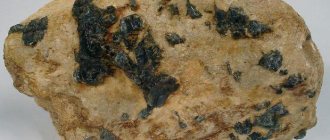Metals in the copper subgroup are characterized by low chemical activity, for this reason they are found in the form of chemical compounds, as well as nuggets. Many centuries ago, copper could only be found in the form of sulfur compounds - chalcopyrite and chalcocite. This is because copper has a high chemical affinity for sulfur. Most primary ores contain copper in sulfide form - CuS. Over time, especially under conditions of volcanic activity, under the influence of large amounts of oxygen, copper sulfides became oxides. Copper nuggets were formed in nature during the strong heating of oxidized sulfur ore. For example, if oxidized copper minerals and sulfur ores lay under a thick layer of rock, they were heated by natural disasters and earthly heat. In such natural “metallurgical shops” colossal volumes of copper were smelted. A nugget weighing 420 tons was found in North America. However, this is rare; native copper on the planet is approximately 1%.
World copper deposits
A lot of copper, like other minerals, is located at the bottom of the oceans. At the bottom there are clusters of round stones containing approximately 0.5% copper. According to the analysis of geologists, the reserves of copper ore in the ocean reach 5 billion tons. There are almost 250 copper minerals, but only 20 are used industrially. The main copper ores include:
- chalcocite - Cu2S, which contains 79.8% copper
- chalcopyrite - CuFeS2, which contains 30% copper. This ore accounts for almost 50% of all copper deposits
- bornite - Cu5FeS4, contains from 52 to 65% copper
- covellite – CuS, contains 64% copper.
According to genetic and industrial-geological parameters, copper deposits are:
- stratiform, which include copper shales and sandstones
- pyrites. This group includes native and vein copper
- hydrothermal
- igneous, including the most common ores of the copper-nickel type
- carbonate. This group includes iron-copper and carbonatite ores.
Copper reserves in the world
The largest amount of copper, approximately 65%, occurs in North and South America. European states have 15% of resources, Asian states - 11%, African states - 4.5%. The largest confirmed copper reserves are recorded in Chile. Almost 20% of the world's reserves are located there. And in the USA - 12.7%. In addition to these countries, there is a lot of copper in Poland, Indonesia, Iran, Kazakhstan, China, Uzbekistan, the Philippines, as well as in Zaire, Zambia, Brazil, Canada, Mexico, Panama, Peru and Australia. In each of these states, according to experts, there are about 10 million tons.
Copper ore mining
Due to the low copper content in the ore, its extraction involves processing large volumes of rock. In order to smelt 1 ton of copper, over 200 tons of ore must be processed. Copper mining methods:
- open method. If ore deposits are located close to the earth's surface, then they are developed in this way; the depth of open-pit mining is 150-300 m. The method is characterized by lower losses
- underground method. Using this method, ore is mined from a depth of 500 m, and sometimes from 800-1000 m.
There are five technological systems for field development:
- using self-propelled equipment. This technology is widely used
- using continuous vibration mechanisms
- using hardening goaf backfill. In this case, there is a continuous excavation of reserves of powerful deposits with minimal losses. With the use of such systems, losses are reduced by 3-4 times
- method of extracting ore in horizontal layers. When filling goafs (in underground mines) with hardening compounds, pipes lined with rubber or basalt are used, the service life of which is 50-100 times higher than that of steel
- cyclic-flow technology for the implementation of mining operations.
Table 1. Copper mining in the world
| A country | Ore mining (thousand tons per year) | Reserves (million tons) |
| Chile | 5,38 | 140 |
| USA | 1,16 | 35 |
| Peru | 1 | 30 |
| Indonesia | 0,8 | 35 |
| Australia | 0,85 | 24 |
| Russia | 0,84 | 20 |
| China | 0,62 | 26 |
| World | 14,49 | 467 |
TOP 10 leading countries in the world of copper producers
The metal received its Latin name Cuprum due to its location on the island of Cyprus. Most of it is found in soil (mines) than in water. Element 29 of the periodic table is found, both in pure form and with impurities.
Poland
Perhaps in 2021 Poland will break all production records in history. In 2021, huge fossil deposits were discovered. So far, according to analytical data, Poland refined 630 thousand tons of copper ore last year.
Japan
According to Bloomberg, copper production has fallen sharply. Such trends were noticed due to the exhaustion of mines. The material that can be obtained is of poor quality. State investment in such projects will lead to an increase in prices for fossil fuels. According to agency statistics, only 740 thousand tons were smelted in Japan in 2021.
Canada
Canada is one of the countries with the largest amount of non-ferrous metal deposits in the world. This feature is observed due to the peculiar tectonic location of the territory of the state. Despite the large number of reserves, Canada cannot boast of high numbers due to the presence of ore deep underground. It takes a long time to obtain copper ore and process it. At the same time, the quality of ore is getting worse every year. Last year, 890 thousand tons were produced.
Russia
According to the deputy director of the Ural Metallurgical Company, 2019-2021 may become the starting point for a shortage of minerals in the world. This announcement was made due to the increasing need for copper in the electricity and automotive industries. The production of environmentally friendly cars requires several times more material than the production of conventional vehicles. Last year, 920 thousand tons of minerals were mined in Russia.
Copper production centers
Copper production centers are present in different regions of Russia. Kazakhstan boasts the richest ore deposits. There are also deposits in the Urals. According to the latest data, Russia ranks first in the world in copper ore mining. Copper plants are being built in close proximity to the mines. The raw material factor is the determining component, due to the low content of concentrates in the feedstock. There are 11 copper complexes in the Urals, producing 43% of the country’s copper. In addition to our own raw materials, production also uses those imported from Kazakhstan. There are also waste recycling plants. For example, sulfur dioxide gases, as a byproduct of copper mining, are used to create sulfuric acid, which is then used to make fertilizers.
In the history of mankind, the Stone Age was replaced by the Copper Age, and man made tools and weapons from this metal, not forgetting about stone and bone. The chemical element received its name in honor of the island of Cyprus, where a large center for the mining and processing of copper was located. Today, our focus is on the largest copper deposits in the world.
Leading countries in copper mining and smelting in the world
Production of refined copper in 2007
The leaders in copper ore mining are Chilean companies, thanks to them the state ranks first in the world rankings.
The country produced 5,700 thousand tons of metal, while the total volume was 20,245 thousand tons.
In second place are Chinese mining companies, the leaders in terms of production growth.
Every year the rate of copper ore smelting increases by an average of 1.5%. At the same time, the country exports a significant share of the metal from Chile and Australia.
Chinese mining companies are widespread in many countries of the world, including Afghanistan.
Further, the leading countries in copper smelting are ranked as follows:
Copper production structure
- Peru – produces 1300 thousand tons – 9% of the world volume;
- USA – 1220 thousand tons – 7%;
- Australia – 990 thousand tons – 5%;
- Russia – 930 thousand tons – 5%;
- Congo – 900 thousand tons – 4.5%;
- Zambia -830 thousand tons – 4.1%;
- Canada – 630 thousand tons – 3.5%.
According to the forecasts of world analysts (USGS and ICSG companies), in the coming years the countries' leaders will remain in their places, since most copper deposits have already been explored and are being actively developed. The only thing that is possible is a slight reduction in volumes and, accordingly, an increase in prices, which have been steadily growing since 2011.
Chuquicamata. Chile
One of the world's oldest and largest copper deposits, copper mining began in 1915, and the quarry is located at an altitude of 2,840 m in the Central Andes.
In terms of the volume of ore mined, it lost the palm to Escondida, but in terms of size it remains one of the largest. The quarry is 4.3 km long and 3 km wide. Moreover, work is already underway at a depth of over 850 m.
At the turn of the 60-70s of the last century, the Chilean industry began to develop ore. It should be noted that the company’s employees conduct not only production, but also active exploration to find new deposits.
Escondida. Chile
On the northern edge of the Atacama Desert in the second half of the 20th century, large deposits of copper ores were discovered at an altitude of more than 3 thousand m above sea level.
Over the course of several years, a project was developed, and in 1990, open-pit copper mining began in this part of Chile. By 2011, this quarry had become the largest of all the world's deposits.
2007 was a record year, when 1.5 million copper was extracted from the bowels of the earth. The deposit consists of two huge quarries, and in total over 6,000 people are employed in the extraction and transportation of valuable metal.
Mineral extraction methods
In Russia there are deposits such as shale and sandstone. Copper pyrite, copper-nickel and porphyry copper forms occur here. The mining industry uses various methods to extract minerals from the depths of the earth.
Depending on the depth of occurrence, ore is mined using open or closed methods. There are standards that determine the feasibility of the depth of excavation of soil layers and the use of technologies that reduce their costs.
The work technology includes the following:
- use of self-propelled equipment;
- production of ore extraction directly;
- filling the resulting voids with materials to make further work safe.
With the open method, fossils are selected in layers, this ensures their fullest use. For deep quarries, the technology of cyclic-flow operations is suitable, it depends on the characteristics of the layers.
Negative consequences of mining
When the formations occur at a depth of 500 to 1000 m and deeper, the closed method of copper mining is convenient. This requires vibration mechanisms; the rock is completely excavated and delivered to the surface. The voids formed underground are filled using pipes lined with rubber or basalt resin.
It is economically advantageous to locate the mineral processing industry in close proximity to the places of their extraction. It is also necessary to build plants for recycling waste after processing. This can promote the release of various beneficial products. For example, processing sulfur dioxide makes it possible to obtain useful fertilizers containing sulfur.
Bingham Canyon. USA
A giant deposit, where open-pit copper mining has been carried out since 1863. This is the deepest copper quarry, with a depth of 1,200 m.
The size of the anthropogenic formation is truly amazing. It covers an area of 7.7 km2 and its width is 4 km. According to geologists, ores containing copper will last for many decades, because reserves are estimated at 640 million tons.
Every day, 450 thousand tons of rock are extracted to the surface, and 1,400 workers work on the extraction. In 2013, a landslide occurred in the quarry, stopping work for several months.
Grasberg. Indonesia
The large mine ranks third in terms of production volumes of valuable metal, and it is also the highest quarry, located on Mount Jayi.
20 thousand workers are employed in the extraction of rocks and their processing, and copper reserves, as geologists estimate, amount to 27 million tons. Annual production averages 600 tons of copper, and the gigantic quarry has become a landmark and a symbol of the mining industry.
It is worth mentioning that gold ores are also developed at the mine, and the Indonesian quarry is among the world leaders in terms of gold production volumes.
Collahhuasi. Chile
A large copper mine in northern Chile is being developed by several global companies. 44% each belongs to Chilean and Canadian companies, and a small part is managed by Japanese companies.
Copper reserves are estimated at 17 million tons, and development is carried out in several quarries. In 2004, a new Rosario quarry was launched, which increased the production of copper ore to 400 thousand tons of mine copper.
Development also continues at the Eugene quarry, and ore reserves will last for another 50 years.
World reserves
World proven copper reserves are estimated to range from 654 million to 1,600 million tons.
Copper is a non-ferrous metal that is consumed by many types of industries. The most profitable ore for production is bornite. This is due to its high content and large deposits in the world's subsoil. Rocks containing 0.5–1% of copper are suitable for copper mining. The most common are ores with nickel additives. They make up 90% of all copper-bearing minerals that are economically beneficial for the mining industry.
The largest copper deposits are located in Chile - 34% of all world reserves, which is 140 million tons.
The countries with the largest reserves in the world are: USA - 35 million tons, Indonesia - 35, Peru - 30, Australia - 24, China - 26, Russia - 20.
Global reserves of copper-bearing ores are estimated at 467 million tons. Geologists say that there are about 5 billion tons of deposits of such ore in the world's oceans.
Anniversary. Russia
Copper mining began at Yubileiny in 1996, and when considering copper deposits in Russia, it is one of the largest. It was opened back in 1966.
Geologists who discovered and explored this area in the Republic of Bashkortostan were awarded State Prizes. In terms of the size of the quarry, it is one of the largest in the Russian Federation, and in terms of production volumes it is in 4th place.
It is interesting that there are also gold-containing ores at Oktyabrsky, but not in such large quantities as copper-containing ores are presented.
Russian copper market
Copper production in Russia for 12 months. 2021 increased slightly by 2% compared to 2021. The increase was provided by the enterprises of UMMC and RMK.
The decrease in output at Norilsk Nickel enterprises (-15 thousand tons), as follows from the company’s report, is largely due to a change in the structure of commercial products, a new logic for the distribution of copper semi-products within the company’s divisions, as well as a reduction in the volume of processing of purchased concentrate at the Rostec Group of Companies. It is necessary to note the planned output of the Bystrinsky GOK to the level of 63 thousand tons of copper in concentrate, which brings the GOK very close to the planned 67-68 thousand tons of copper in concentrate annually.
Apparent copper consumption in Russia decreased by 10% compared to 2019, to 286 thousand tons. The excess copper was aimed at increasing the volume of export supplies, which was facilitated by a more attractive external environment. Copper exports increased by 9%, to 742 thousand tons, wire rod - by 4%, to 148 thousand tons.
[1]
In total, at the end of the year, copper production in Peru decreased by 12.5%
Source
Udokan. Russia
The Udokan deposit, located on the mountain range of the same name in the Trans-Baikal region, honorably ranks third in the world in terms of copper reserves of 24.6 million tons.
Copper on Udokan was discovered in 1949 during a forest exploration expedition, and the first mining developments began only at the beginning of the 21st century. As of today, exploration work has stopped at a depth of 1,200 m.
The difficulty of mining lies in the fact that copper ore deposits are located in the permafrost belt, and even in an earthquake-prone area of the planet.
Geography. Grade 10
Lesson summary
Item name, class:
geography, 10th grade
Lesson number and topic name:
lesson No. 12
“
World metallurgy”
List of issues discussed in the topic:
- Mining industry.
- Geography of the mining industry.
- Ferrous metallurgy.
- Non-ferrous metallurgy.
- Copper industry.
- Aluminum industry.
- Geography of metallurgy.
Glossary on the topic:
mining industry, metallurgy, ferrous metallurgy, non-ferrous metallurgy.
Theoretical material for self-study
Mining industry
has a significant impact on the territorial structure of the world economy and the international geographical division of labor. Despite the gigantic volumes and variety of extracted resources, the world maintains a stable dependence on raw materials. It can be traced in the directions of global “raw materials bridges” between areas of resource production and consumption, between developing and developed countries.
The global crisis of raw materials and energy resources of the 20th century changed the geography of the mining industry. Developed countries had to rely on their own resources, and now Canada, Australia, and South Africa provide two-thirds of their raw material needs. Great mining powers also include the USA, China, India, Brazil, and Russia. The resources of highly specialized countries are of great importance. Chile and Peru - copper industry, Sierra Leone and Rwanda - tin industry, Guinea and Jamaica - bauxite mining.
Metallurgy
includes mining, beneficiation of ore resources and production of ferrous and non-ferrous metals. Iron ore contains on average 50-60% metal. Ferrous metallurgy is the production of steel and cast iron, iron-based alloys. The achievements of scientific and technological revolution influenced the creation of new structural materials and a reduction in the metal intensity of production, but still steel production exceeded 1,500 million tons per year. The role of the countries of the South has increased: India, the Republic of Korea, Brazil, India are the leading powers in the production of ferrous metals, and China is the absolute leader in this indicator. Germany, France, Italy, Great Britain, USA, Canada, Russia and Ukraine remain major producers.
There are certain shifts in the distribution of ferrous metallurgy. The historical focus of metallurgical industries on coal and iron reserves was replaced by their cargo flows. Therefore, the deep location of metallurgical enterprises (as in Germany, France or Poland) is increasingly being replaced by coastal or port ones (as in Italy, South Korea, Japan). The creation of mini-plants for processing scrap steel is another trend in modern metallurgy, which reflects its focus on the consumer.
The United States, Western European countries, Japan, as well as China, the Republic of Korea, and Taiwan remain major consumers of ferrous metallurgy products.
Non-ferrous metallurgy
includes the production of heavy, light, alloying, noble and rare earth metals. Russia, the USA, Japan and Germany have the most complete range of smelted non-ferrous metals. In terms of consumption volumes in the first half of the 20th century, heavy metals - copper - were in the lead, and in the second half - light metals, for example, aluminum.
Heavy metals are characterized by a low content of useful substances in the ore - up to 1-2%, therefore the extraction, enrichment and production of a refined product is tied to deposits. The Central African Copper Belt is an example of such production. The copper industry covers 45% of the needs of electronics and electrical engineering, 10% of mechanical engineering, and is of great importance for the innovative economy. The production of pure copper - refining - requires a lot of electricity, so part of the blister copper is exported to countries such as the USA, China, Japan, and Germany. Copper production in the world is steadily growing due to the Asian region, which also leads in the production of pure copper. And if the key exporters in this industry are Chile, Peru, Russia, Australia and Canada, then the leading importers are China, the USA, Japan, India, South Korea and Taiwan.
Light non-ferrous metals are contained in the ore by 50-60% and are quite transportable. This allows the process of their production to be geographically divided. Let's consider the production of aluminum. Aluminum reserves in the world are estimated at 7000 million tons. Aluminum ore - bauxite and nepheline - is mined in Australia, China, Brazil, Guinea, and Jamaica. Alumina (aluminum concentrate) is produced at raw material sources. A third of the mined bauxite is sent for processing to developed countries - the USA, Ireland, Spain and China, which has become the leader in aluminum production in the world. Pure (primary) aluminum is produced from alumina from sources of cheap electricity (hydroelectric power plants) in China, Russia, Canada, India, and Australia. Without aluminum it is impossible to imagine construction, transport engineering, and electric power. This metal is of great importance in the production of packaging materials and foil.
The global economy is bringing into its circulation an increasing number of rare, alloying, and precious metals. Thus, Australia, Russia and South Africa are the leaders in terms of proven gold reserves. But China is ahead of these countries in terms of gold exports. Peru, Chile, Bolivia, and Australia have large reserves of silver. The leaders in production are Mexico and China. China is also the absolute leader in reserves and production of rare earth metals.
Examples and analysis of solutions to training module tasks
- Using the data in Figure 1, calculate how many years gold will last for the USA, Russia, China, Mexico, and South Africa.
Figure 1 – Gold production and reserves
To complete the task you must:
- divide the indicator of economic gold reserves by the production indicator for each of the specified countries. For the USA: 3000 / 200 = 15 years;
- Round the answer to a whole number and write it in the appropriate cell. For the USA: 15 years - 15 years.
Answers: USA – 15; Russia – 33; China – 4; Mexico – 12; South Africa - 43.
- Using the data in Figure 2, plot the European countries that are leaders in steel production on an interactive contour map.
Figure 2 – Largest steel producers
To complete the task, you need to select European countries from the list and mark them on the contour map with a symbol.
Basic and additional literature on the topic of the lesson:
- Maksakovsky V. P. Geography. 10-11 grades Textbook. A basic level of. (FSES). – M.: Education, 2021. – 416 p. : ill.
- Rodionova I. A., Elagin S. A., Kholina V. N., Sholudko A. N. Economic, social and political geography: the world, regions, countries: Educational and reference manual / Ed. prof. I.A. Rodionova. – M.: Ekon-Inform, 2008. – 492 p.
- Geography: a reference book for high school students and those entering universities. – 2nd ed., rev. and revision – M.: AST-PRESS SCHOOL, 2008. – 656 p.
Open electronic resources on the topic of the lesson:
Nurkazgan. Kazakhstan
The entire periodic table has been collected in the depths of the Kazakh steppes. And one of the largest copper mines in Kazakhstan is located in the north of the country, and is part of the unified system of the Nurkazgan Mining and Processing Corporation.
Exploration work has been carried out since the late 90s, and the mine was put into operation in 2006. A little more than 700 workers are employed in mining.
Employees of Kazakhmys, which owns the rights to develop and mine gold and copper, estimate Nurkazgan’s copper reserves at 1.8 million tons.
Copper ore: properties and characteristics
Copper is a plastic element with a golden-pink hue. In the open air, the metal is immediately covered with an oxygen film, which gives it a specific red-yellow color.
Characteristic properties: corrosion resistance, high thermal and electrical conductivity.
At the same time, the element has high antibacterial properties and destroys influenza viruses and staphylococci.
In the industrial complex, copper is most often used in alloys with other components: nickel, zinc, tin, gold, etc.
Uyu Tolgoi. Mongolia
The Mongolian mine specializes in the extraction of gold and native copper. Experts consider the mine one of the most promising in terms of the use of new technologies that will increase production volumes.
Copper mining was suspended in 2013 due to disagreements between Mongolian authorities and the Austro-Belgian exploration and mining company.
But Rio Tinto PLC, which owns the majority of the shares, presented a new promising project in which it invested more than $5 billion.
Sibay. Russia
The quarry located in Bashkiria was opened in 1913, and copper mining began in the 30s of the twentieth century. The first exploration work was carried out in 1915, and already at that time a small copper smelter began operating nearby.
The largest site, Novo-Sibaisky, consists of 3 large lenses connected to each other by a common ore column. The depth of the quarry is just over 500 m, and its dimensions are 1.4 km by 1.3 km.
The deposit is considered the standard of pyrite ore deposits of the Ural group. In addition to copper, zinc is also mined at the mines, and according to experts, the reserves will last for many more decades.
By the way, on our website thebiggest.ru there is an informative article about the highest mountains of Bashkortostan.
